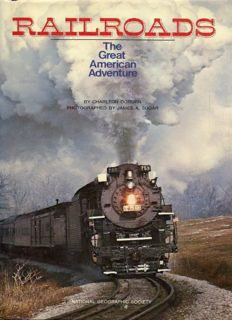
Railroads: The Great American Adventure PDF
Preview Railroads: The Great American Adventure
i tefa ^bMiJ By Charlton Ogbum Iiailroads:ff| Photographed byJames A. Sugar Prepared by the Special Publications Division National Geographic Society, Washington, D. C. i American Great riie xldi-eiiture Trainman andfriend walk toward a steam locomotive in Durango, Colorado. Railroads: The Great American Adventure Drayton H.\wtcins.DesignAssistant ByCharlton Ogburn Willi.\M R. GR-\y.Editor. PictureLegends PhotographedbyJamesA. SuG.\R ]\L\rg-aretM. C.\rter. Christine K. Eckstrom. Louisa M.agz.\nlan. Tom Melram. H. Robert Publishedby Morrison.James A. Sugar. Edward 0. The Nation.\lGeographic Society Welles. Jr.. PictureLegends Robert E. Doyle,President Production andPrinting Melvin M. Payne. Chairman oftheBoard Robert \^'. Messer. Production Manager GilbertM. Gros\t;nor.Editor George \'. \^"hite.AssistantProduction Manager Melville BellGrosvenor,Editor-in-Chief Raja D. Mit^shed.Jltve L. Graham. Christine Preparedby A. Roberts.ProductionAssistants The SpecialPl^blicationsDivision John R. Metcalfe.EngravingandPrinting Robert L. Breeden.Editor Debra A. .\ntonini.Jane H. Buxton. Stepranie DonaldJ. Crltmp.AssociateEditor S. Cooke. .\licl\ L. Diffenderffer. Suz.a.nne Philip B. Silcott.SeniorEditor J. Jacobson. Cleo Petroff. jN.\ncyJ. Watson, MerrillWindsor.ManagingEditor Marilyn L. Wilbltr.StaffAssistants CarolA. Enquist,JenniferC. Urquhart, Anne K. McCain.Index Research IllustrationsandDesign Cop>Tight © 1977NationalGeographicSociety. .\11rights resen'ed. Reproductionofthewhole oranypart ofthe David R. Bridge. PictureEditor contentswithoutwritten permissionisprohibited. JODY Bolt.ArtDirector Suez B. Kehl.AssistantAnDirector Library ofCongress CIP Data: page200 Page2-3:Shiningrails recedebehindanAmtrakpassengertrainspeedingthrough theeastern Washington countryside. Page I:Railroader'sstandby—asturdywatch oftestedaccuracy.Front endpaper:Steam onceturnedthe mighty wheelsofthe Memnon, nowin theB&ORailroadMuseum.Backendpaper: Weedsgrowbesiderustedwheelsofan abandonedengineinNewMexico.Bookbinding: Bythemid-19th century,thelocomotivehadattainedthisclassicform. Fowwoiil Come all you rounders, I uant you to hear. The story told ofa brave engineer. . . . SO BEGINS the immortal ballad ofrailroader "Casey" Jones, whodied in one of history's most famous train wrecks. The song is more than a eulogy; its spirit and message staunchly proclaim America's durable love affair with the iron horse. Highlijihts of a memorable era leap to mind: the Great Locomotive Chase ofthe Civil War. pounding home . . the golden spike at Promontory. Utah . . . Butch Cassidy, Jesse James, and other train robbers battling the Pinkertons George Mortimer . . . Pullman's famous sleeping cars . . . Fred Harvey and the Harvey girls droves of hoboes during the Depression the Twentieth Century . . . . . . Limited, renowned for comfort, fine meals, and on-time service. . . . The list goes on. In today's world of supersonic planes and eight- lane freeways, we tend to forget the tremendous impact that railroads have had upon our nation and our lives. Not very long ago. almost every town boasted a railway station, and that station was likely to be its hub. Here people congregated, not only to travel and do business, but also to see and be seen, and perhaps to eat in its restaurant or at one of the hotels that sprouted nearby. This was railroading's romantic age. when heroes rode smoke-belching locomotives in folk songs and dime novels, and trains established such a reputation for holding to schedules that "the farmers set their clocks by them." wrote Henry David Thoreau. Of course, railroads also served more pragmatic functions. They tamed the West and opened it to settlement, enabling millions of new- comers to realize the American dream—a homestead oftheirown. They contributed mightily to America's industrial and economic growth. They carried the mails, transported raw materials to factories and finished products to market, and made some oftheir owners very, very rich. Railroads affected all Americans, from Vanderbilt and Harriman to the nameless, down-and-out drifters who sought a wind-free corner aboard the next slow freight. Today, though they are less visible, trains remain vital to America. We at National Geographic rely on them to bring us virtually all ofour paper stock, and todistribute about 80 percent ofthe nine and a halfmil- lion copies ofour magazinepublishedeach month. Despite America's ex- tensive trucking and airhne industries, railroads still carry the most freight. Passenger bookings, down considerably from the 1944 record of 97.7 billion passenger-miles, are now on the rise with Amtrak—and should continue to increase with our concern for energy conservation. The reason is simple—trains represent our most fuel-efficient trans- portation system. In the high-density corridors, they offer an additional advantage: Unlike trucks or planes, they can convert to electricity (and thus, in many cases. tt» non-petroleum energy sources). With high-speed rails, computerized controls, and reemphasis on service, passenger trains may yet renew their long romance with the American people. And then, who knows? Perhaj)? we'll find ourselves with not only a healthier economy, but a whole new round of railroad folklore as well! Gilbert M. Grosvenor Sunlight spills into the baggage car as conductor Fred Walters ofThe' li Contents Foreword 5 1 From Teakettle-on-Wheels to Iron Horse 9 2 Buccaneers and Builders: Spanning a Continent 45
Description: